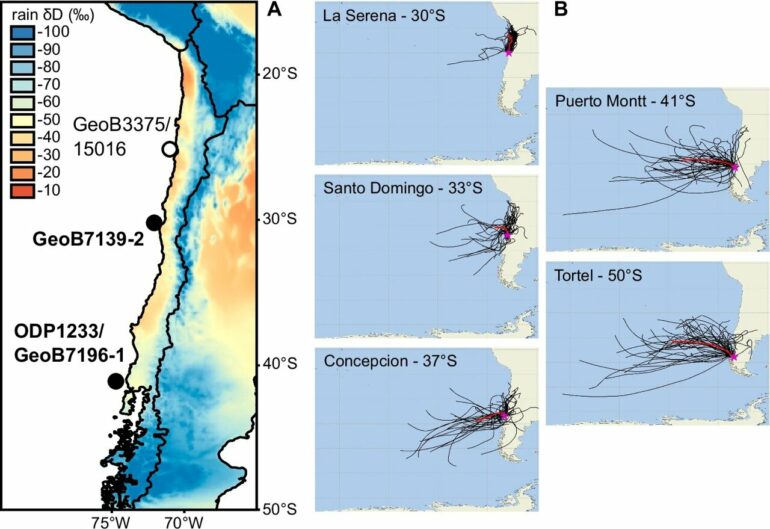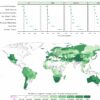A research team led by the Leibniz Institute for Baltic Sea Research Warnemünde (IOW) has analyzed 50,000 years of mid-latitude hydroclimate of the South-East Pacific using special moisture related indicators in marine sediment cores. They have found that natural variations in the Earth’s orbital parameters exert a decisive influence.
Understanding the causes of changing humidity and precipitation in the Earth’s past is crucial for better assessments of the planet’s future hydroclimate changes through improved modeling. One field that climate researchers around the world are focusing on is hydroclimate—i.e. the entirety of all long-term weather phenomena in a region that determine the amount of precipitation and humidity. After all, the Intergovernmental Panel on Climate Change (IPCC) states unequivocally: As climate change progresses, the risk of hydroclimate extremes—both droughts and heavy rainfall events—increases.
“Understanding the hydroclimate of a region or modeling future scenarios is anything but trivial and involves major uncertainties as it is the result of an extraordinarily complex interplay of many factors,” says Jérôme Kaiser from the IOW. “Analyzing changes in the Earth’s climate far back into the past can help to recognize patterns and thus identify important influencing factors.”
The expert in paleoceanography and paleoclimate is lead author on a study in Nature Communications, now published together with researchers from the Alfred Wegener Institute Helmholtz Centre for Polar and Marine Research, the MARUM—Centre for Marine Environmental Sciences at the University of Bremen and two Chilean universities, the University of Magallanes in Punta Arenas and the Santiago-based University of Chile.
The study provides a glimpse into the paleoclimatic past by analyzing several sediment cores from the South-East Pacific, which were recovered from water depths between 850 and 3,300 meters on the continental slope off the northern and southern Chilean coast.
“Marine sediments, which are deposited over thousands of years in layers that can be dated quite well, are excellent archives from which we can reconstruct past environmental conditions on Earth using certain indicators—so-called environmental proxies,” explains Kaiser.
The cores used in the present study reflect a period of about 50,000 years. The research team primarily focused on the content of deuterium, a naturally occurring hydrogen isotope, in leaf waxes of land plants, which are deposited in marine sediments.
“We know that different deuterium levels say a lot about the precipitation conditions in a region—about the amount and intensity of the precipitation, and even about the origin of the humidity from which the precipitation has formed,” Kaiser explains the approach.
The results show clear patterns for the sources of humidity and the amount of precipitation in the mid-latitude hydroclimate of the southeast Pacific: While in southern Chile the rain was mainly brought by the sub-Antarctic westerly winds, the precipitation in the mid-latitudes of Chile also came from the subtropics. The amount and origin of precipitation from these sources in the two regions, however, is subject to significant fluctuations over the millennia.
“It was particularly interesting for us that the fluctuations in the amount and intensity of precipitation follow distinctive time cycles, which only became visible thanks to the long period represented by the sediment cores: In central Chile, the cycle length is 23,000 years, whereas in southern Chile it is 41,000 years,” Kaiser points out.
These temporal patterns correlate very well with temporal cycles of natural changes in the Earth’s orbit around the sun: During a phenomenon known as “precession,” which correlates with the shorter precipitation cycle in central Chile, the Earth’s axis undergoes a cone-shaped rotation and thus changes the planet’s orientation in relation to the sun.
In addition, the Earth’s axis also changes its inclination within the planet, which is known as the “Earth axis tilt phenomenon” and also affects the planet’s positioning towards the sun. It correlates with the longer time cycle of precipitation in southern Chile.
“Both orbital phenomena influence the intensity of the solar radiation in different regions by changing the tilt of the planet. And this in turn has consequences for the winds that transport moisture and rain,” says Kaiser. That the Earth’s orbital variability has climatic consequences has long been hypothesized and taken into account in regional climate models, the paleoclimate expert continues.
“However, based on the results of the deuterium measurements, our study provides concrete evidence that the hydroclimate of Chile’s mid-latitudes is substantially controlled by orbital parameters. And hydroclimatic extremes in south-central Chile, such as the very high levels of precipitation during the last ice age and the pronounced drought of the early Holocene, can also be plausibly explained by orbital changes,” says Kaiser.
The Warnemünde-based researcher goes even further in his conclusions.
“It can’t be a matter of blaming extreme hydroclimatic events entirely on natural changes in the Earth’s obliquity. But to correctly recognize the signal of anthropogenic climate change impacts, we need to better understand the fluctuations, which are subject to natural influences, and also take into account that natural and anthropogenic fluctuations can add up in terms of impact.
“Naturally, this also applies to northern and central Europe, where the Earth’s variable orbit also has a climatic impact.”
More information:
Jérôme Kaiser et al, Orbital modulation of subtropical versus subantarctic moisture sources in the southeast Pacific mid-latitudes, Nature Communications (2024). DOI: 10.1038/s41467-024-51985-4
Provided by
Leibniz-Institut für Ostseeforschung Warnemünde
Citation:
Hydroclimate study finds natural variations in Earth’s tilt affect precipitation and humidity (2024, September 12)



